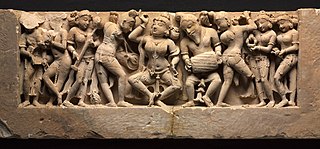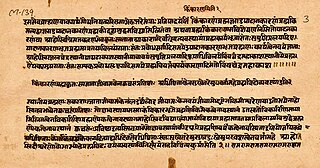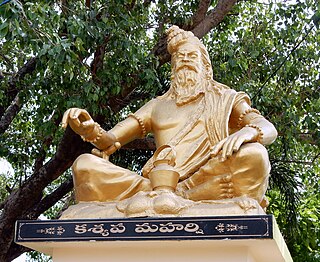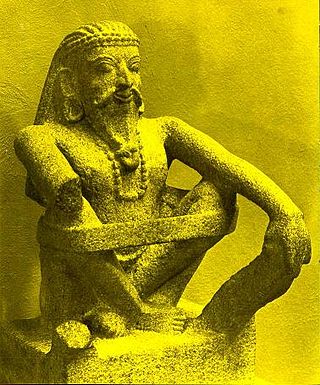
Garuda is a Hindu demigod who is primarily depicted as the mount (vahana) of the Hindu god Vishnu. This divine creature is mentioned in the Hindu, Buddhist and Jain faiths. Garuda is also the half-brother of the Devas, Gandharvas, Daityas, Danavas, Nāgas, Vanara and Yakshas. He is the son of the sage Kashyapa and Vinata. He is the younger brother of Aruna, the charioteer of the Sun. Garuda is mentioned in several other texts such as the Puranas and the Vedas.

Kurma, is the second avatar of the Hindu preserver deity, Vishnu. Originating in Vedic literature such as the Yajurveda as being synonymous with the Saptarishi called Kashyapa, Kurma is most commonly associated in post-Vedic literature such as the Puranas. He prominently appears in the legend of the churning of the Ocean of Milk, referred to as the Samudra Manthana. Along with being synonymous with Akupara, the World-Turtle supporting the Earth, Kurma is listed as the second of the Dashavatara, which are the ten principal incarnations of Vishnu.

Svarga, also known as Indraloka and Svargaloka, is the celestial abode of the devas in Hinduism. Svarga is one of the seven higher lokas in Hindu cosmology. Svarga is often translated as heaven, though it is regarded to be dissimilar to the concept of the Abrahamic Heaven.
Hindu texts are manuscripts and voluminous historical literature which are related to any of the diverse traditions within Hinduism. A few of these texts are shared across these traditions and they are broadly considered Hindu scriptures. These include the Itihasa and Vedas. Scholars hesitate in defining the term "Hindu scriptures" given the diverse nature of Hinduism, but many list the Agamas as Hindu scriptures, and Dominic Goodall includes Bhagavata Purana and Yajnavalkya Smriti in the list of Hindu scriptures as well.

Deva means "shiny", "exalted", "heavenly being", "divine being", "anything of excellence", and is also one of the Sanskrit terms used to indicate a deity in Hinduism. Deva is a masculine term; the feminine equivalent is Devi.

Vasuki is the second king of the nagas in Hinduism. He is described as having a gem called Nagamani on his head. Shesha, the first king of the nagas and the bed on which Vishnu rests, is his elder brother, and Manasa, another naga, is his sister. In Hindu iconography, he is generally depicted coiling around the neck of Shiva, who is believed to have blessed and worn him as an ornament.

Aruna is the charioteer of Surya in Hinduism. He is the elder brother of Garuda. Aruna and Garuda are the sons of Vedic sage Kashyapa and his wife Vinata, daughter of Prajapati Daksha. His children were Sampati and Jatayu. He is also found in Buddhism and Jainism literature and arts.

Śrauta is a Sanskrit word that means "belonging to śruti", that is, anything based on the Vedas of Hinduism. It is an adjective and prefix for texts, ceremonies or person associated with śruti. The term, for example, refers to Brahmins who specialise in the śruti corpus of texts, and Śrauta Brahmin traditions in modern times can be seen in Kerala and Coastal Andhra.

The Shvetashvatara Upanishad is an ancient Sanskrit text embedded in the Yajurveda. It is listed as number 14 in the Muktika canon of 108 Upanishads. The Upanishad contains 113 mantras or verses in six chapters.

In Hinduism, Uchchaihshravas is a seven-headed flying horse, created during the churning of the milk ocean. It is considered the best of horses, the prototype and the king of the horses. Uchchaihshravas is often described as a vahana ("vehicle") of Bali, the king of the asuras (demons). Uchchaihshravas is said to be snow white in colour. Uchchaishravas was created in Samudra Manthan and was given to the asuras.
Kadru is usually regarded as the daughter of Daksha and the consort of the sage Kashyapa in Hindu scriptures. Kashyapa is the son of Marichi, who is a manasaputra, a mind-born son of Brahma. Kadru is best known as the mother of the nagas, the race of serpents.

In Hinduism, Vinata is the mother of Aruna and Garuda. She is one of the daughters of Prajapati Daksha. She is married to Kashyapa, along with several of her sisters. She bears him two sons, the elder being Aruna and the younger being Garuda.

Vishnu, also known as Narayana and Hari, is one of the principal deities of Hinduism. He is the supreme being within Vaishnavism, one of the major traditions within contemporary Hinduism.

Kashyapa is a revered Vedic sage of Hinduism. He is one of the Saptarishis, the seven ancient sages of the Rigveda. Kashyapa is the most ancient and venerated rishi, along with the other Saptarishis, listed in the colophon verse in the Brihadaranyaka Upanishad.

Garuda Upanishad or Garudopanishad is one of 108 Upanishadic Hindu scriptures, written in Sanskrit language. It is dedicated to Garuda, the eagle-demigod mount of the god Vishnu. It is a Vaishnava Upanishad, and associated with the Vaishnava sect, which worships Vishnu, and is associated with the Atharvaveda. It is considered as "late" Upanishad in terms of dating. The Garuda Upanishad has mantras and charms that are said to cure poison. The text says that its charms can not only prevent and remedy snakebite and the venom, but also poison from any other source like other poisonous animals, weapons and supernatural beings.

Vasudeva Upanishad (Sanskrit: वासुदेव उपनिषत्, or Vasudevopanishad is one of 108 Upanishadic Hindu texts, written in Sanskrit language. It belongs to the Vaishnava sect, which worships Vishnu and his avatar Krishna, and this late medieval era minor Upanishad is attached to the Samaveda. It is one of the 14 Vaishnava Upanishads dedicated to Vaishnava sacred marks, including the Urdhva Pundra - the Vaishnava tilaka. It is described in a sermon by Krishna to the sage Narada.

Agni is a Sanskrit word meaning fire and connotes the Vedic fire deity of Hinduism. He is also the guardian deity of the southeast direction and is typically found in southeast corners of Hindu temples. In the classical cosmology of the Indian religions, Agni as fire is one of the five inert impermanent elements (pañcabhūtá) along with space (ākāśa), water (ap), air (vāyu) and earth (pṛthvī), the five combining to form the empirically perceived material existence (Prakṛti).

The Mantrika Upanishad is a minor Upanishad of Hinduism. The Sanskrit text is one of the 22 Samanya Upanishads, is part of the Vedanta and Yoga schools of Hindu philosophy literature, and is one of 19 Upanishads attached to the Shukla Yajurveda. In the Muktika canon, narrated by Rama to Hanuman, it is listed at number 32 in the anthology of 108 Upanishads.

The Subala Upanishad, also called Subalopanishad (सुबालोपनिषत्), is an Upanishad written in Sanskrit. It is attached to the Shukla Yajurveda, and classified as one of the Samanya Upanishads of Hinduism.
Shakta Upanishads are a group of minor Upanishads of Hinduism related to the Shaktism theology of a Goddess (Devi) as the Supreme Being. There are 8 Shakta Upanishads in the Muktika anthology of 108 Upanishads. They, along with other minor Upanishads, are generally classified separate from the thirteen major Principal Upanishads considered to be from the ancient Vedic tradition.
















